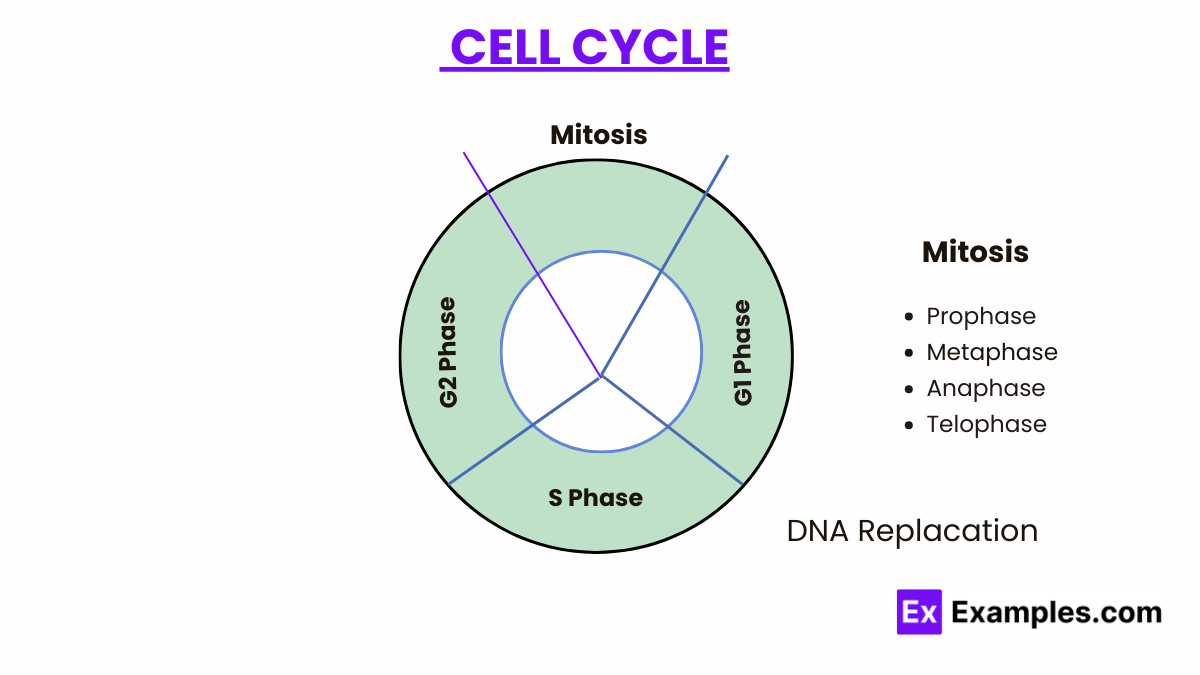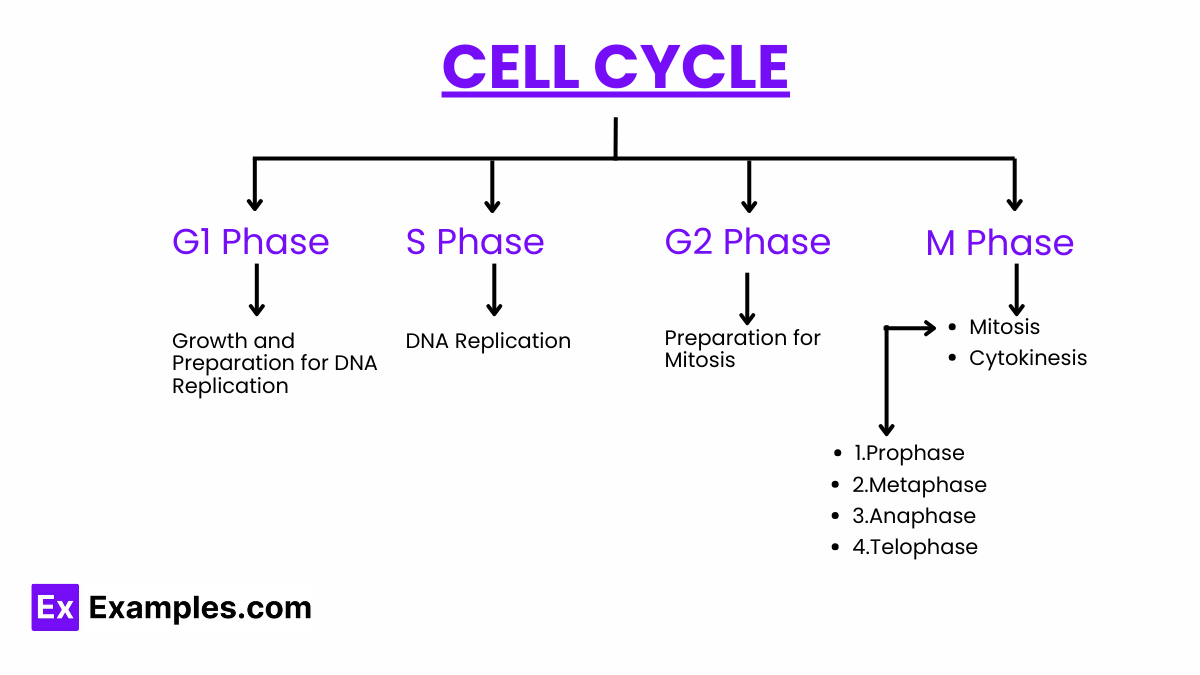Which phase of the cell cycle is characterized by the replication of DNA?
G1 phase
S phase
G2 phase
M phase


Dive into the fascinating world of the cell cycle, the essential process governing cell growth and division across all living organisms. This comprehensive guide illuminates the stages from interphase to mitosis, highlighting the orchestrated events that enable cells to duplicate their DNA and split into two. Explore real-world examples that demonstrate the cell cycle’s critical role in development, tissue repair, and cancer research. Unlock the secrets of cellular replication and discover how understanding the cell cycle paves the way for breakthroughs in medical science.
The cell cycle represents the series of events that take place in a cell leading to its division and duplication (replication). It is the cornerstone of cellular organization and growth, ensuring that cells reproduce accurately and healthy. The cell cycle is meticulously regulated and can be divided into two major phases: interphase and the mitotic (M) phase.

The cell cycle is divided into two major phases: interphase and the mitotic phase (M phase).
The cell grows in size and synthesizes mRNA and proteins necessary for DNA replication. It’s a phase of metabolic activity and growth.
DNA replication occurs, ensuring that each daughter cell will receive an exact copy of the cell’s DNA.
The cell continues to grow and prepares for mitosis, synthesizing proteins and organelles needed for cell division.
The mitotic phase includes mitosis and cytokinesis, leading to the physical division of the cell into two daughter cells
The cell cycle is tightly regulated by a complex network of signaling pathways, involving cyclins, cyclin-dependent kinases (CDKs), and various checkpoint proteins. These regulatory molecules ensure that each phase is completed accurately before the cell proceeds to the next stage, preventing errors such as DNA damage or incomplete replication that could lead to mutations or cell death.
The regulation of the eukaryotic cell cycle involves a sophisticated network of cyclins, cyclin-dependent kinases (Cdks), and various checkpoint proteins that ensure the cycle proceeds at the right time and in the correct order.
The eukaryotic cell cycle is also influenced by several signaling pathways that respond to internal and external cues, such as DNA damage, nutrient status, and cell size.
Understanding the regulation of the eukaryotic cell cycle has profound implications for cancer therapy, as many cancers are characterized by deregulated cell cycle control. Targeting specific regulators of the cell cycle, such as cyclin-Cdk complexes or checkpoint kinases, offers a strategy for developing cancer therapeutics. Additionally, research into cell cycle regulation can provide insights into developmental biology, stem cell biology, and aging.
Fluorescence imaging of the cell cycle stands as a revolutionary technique in cellular biology, allowing researchers to visualize and track the dynamic processes of cell division in real-time. This method employs fluorescent markers to highlight specific proteins or structures within the cell, enabling the detailed observation of cell cycle progression, from DNA replication to mitosis. This comprehensive guide explores the principles, techniques, and applications of fluorescence imaging in studying the cell cycle, shedding light on its importance in advancing our understanding of cellular processes and disease mechanisms.
Fluorescence imaging is based on the excitation of fluorescent dyes or proteins by specific wavelengths of light, causing them to emit light at different wavelengths. When these fluorescent markers are attached to molecules or structures of interest within the cell, they allow for the direct observation of cellular processes under a fluorescence microscope. The specificity and sensitivity of fluorescence imaging make it an indispensable tool for cell cycle studies.
 Several techniques are employed in fluorescence imaging of the cell cycle, each offering unique insights into the cellular processes:
Several techniques are employed in fluorescence imaging of the cell cycle, each offering unique insights into the cellular processes:
Fluorescence imaging of the cell cycle has broad applications in biological research, including:
While fluorescence imaging of the cell cycle provides invaluable insights, it also faces challenges such as phototoxicity, where prolonged exposure to light can damage cells, and photobleaching, where fluorescent markers lose their brightness over time. Advances in fluorescent proteins, imaging techniques, and computational analysis are continually being developed to overcome these challenges, promising even more detailed and accurate observations of the cell cycle in the future.
The evolution of the cell cycle is a fascinating journey through the history of life on Earth, reflecting the intricate changes that have enabled cells to proliferate, adapt, and evolve in response to environmental pressures and opportunities. This comprehensive guide explores the evolutionary advancements of the cell cycle, shedding light on how cellular replication mechanisms have diversified across different life forms and contributed to the complexity of life as we know it today. Understanding the evolution of the cell cycle not only illuminates the past but also provides insights into future directions in biology, medicine, and evolutionary research.
The cell cycle’s evolutionary roots trace back to the earliest forms of life, with prokaryotic cells exhibiting simple division processes like binary fission. As life evolved, the need for more controlled and accurate cell division led to the development of the eukaryotic cell cycle, characterized by sophisticated checkpoints and regulatory mechanisms ensuring DNA integrity and proper segregation.
Studying the cell cycle across different species has revealed both conserved mechanisms and unique adaptations. For example, the basic machinery of the cell cycle is remarkably conserved from yeast to humans, highlighting its fundamental importance. However, specific adaptations, such as those enabling certain plants and animals to undergo rapid cell cycles or dormancy periods, illustrate the cell cycle’s flexibility in response to ecological niches.
The cell cycle comprises distinct phases: G1 (cell growth), S (DNA synthesis), G2 (preparation for mitosis), and M phase (mitosis and cytokinesis), regulating cell division and replication.
The four major stages of mitosis are prophase, metaphase, anaphase, and telophase, which describe the process of chromosome condensation, alignment, separation, and division into two nuclei.
The cell cycle is a series of regulated steps a cell undergoes leading to its division and duplication, ensuring accurate DNA replication, division, and cell function.
The cell cycle is a fundamental process governing cell growth and division, essential for life. Its intricate regulation ensures genetic fidelity and proper cellular function, impacting development, repair, and disease. Understanding the cell cycle’s mechanisms offers valuable insights into biology and medicine, providing a basis for innovations in cancer therapy, regenerative treatments, and genetic research, marking its significance in the science of life.
Text prompt
Add Tone
10 Examples of Public speaking
20 Examples of Gas lighting
Which phase of the cell cycle is characterized by the replication of DNA?
G1 phase
S phase
G2 phase
M phase
What happens during the G1 phase of the cell cycle?
DNA replication
Cell growth and normal metabolic roles
Division of the nucleus
Cell division
Which checkpoint ensures that DNA is not damaged before entering the S phase?
G1 checkpoint
S checkpoint
G2 checkpoint
M checkpoint
What is the primary purpose of mitosis in multicellular organisms?
Reproduction
Growth and repair
Energy production
Nutrient absorption
Which phase of mitosis involves the alignment of chromosomes at the cell's equator?
Prophase
Metaphase
Anaphase
Telophase
What occurs during anaphase of mitosis?
Chromosomes condense and become visible.
Chromosomes align at the cell equator.
Sister chromatids separate and move to opposite poles.
Nuclear membrane reforms around chromosomes.
Which of the following events marks the completion of cytokinesis?
Formation of two daughter nuclei
Splitting of the cell's cytoplasm
Alignment of chromosomes
DNA replication
What role do cyclins and cyclin-dependent kinases (CDKs) play in the cell cycle?
They repair DNA damage.
They regulate the timing of the cell cycle.
They condense chromosomes.
They transport nutrients.
Which process ensures genetic diversity during cell division?
Mitosis
Cytokinesis
Meiosis
Binary fission
What is the primary function of the G2 checkpoint in the cell cycle?
Ensure DNA is accurately replicated.
Check for chromosome alignment.
Monitor cell size and DNA integrity.
Control the entry into G0 phase.
Before you leave, take our quick quiz to enhance your learning!

